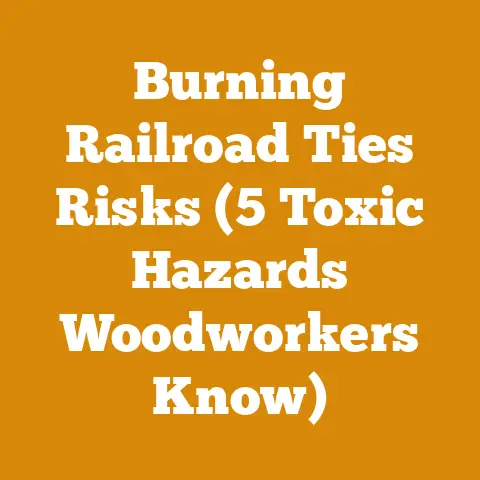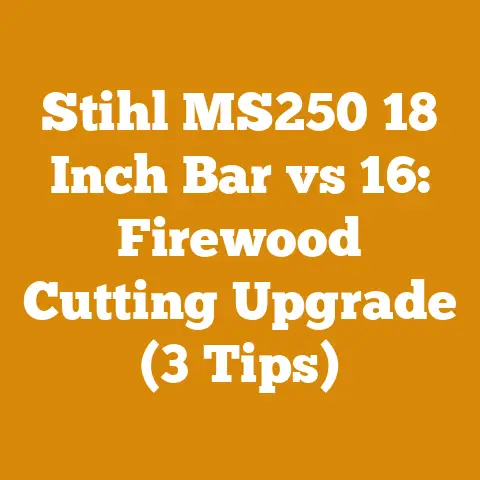Husqvarna 520iLX Battery Brushcutter (5 Pro Tips for Tough Wood)
Taming the Wild: Pro Tips and Cost Considerations for Brushcutting with the Husqvarna 520iLX
I remember the first time I tackled a serious brush clearing project. It was a renovation job on an old farmhouse my wife and I bought – a fixer-upper in the truest sense of the word. The property was beautiful, but the overgrown brush and saplings were threatening to swallow the place whole. I underestimated the sheer volume of work and, more importantly, the cost involved. I ended up blowing my initial budget before I even got to the fun parts, like restoring the porch swing! That experience taught me the value of proper planning, the right tools, and a realistic understanding of the costs involved in any wood processing or land clearing endeavor.
This time, let’s talk about brush clearing with the Husqvarna 520iLX battery brushcutter. I will share some pro tips for handling tough wood and, more importantly, delve into the often-overlooked costs associated with this type of work, from the initial investment in the tool itself to the ongoing expenses of operation and maintenance.
Understanding the Husqvarna 520iLX: A Brushcutter for the Modern Era
The Husqvarna 520iLX is a powerful, battery-operated brushcutter designed for professional use. It’s known for its lightweight design, excellent balance, and quiet operation, making it a favorite among landscapers, groundskeepers, and even homeowners with demanding property maintenance needs. Its appeal lies in its ability to tackle thick grass, weeds, and even small saplings with ease, all without the noise and fumes of a traditional gas-powered machine.
5 Pro Tips for Taming Tough Wood with the 520iLX
Before we dive into the financial aspects, let’s equip you with some practical tips to maximize the 520iLX’s performance, especially when dealing with tougher woody material:
-
Blade Selection is Key: The 520iLX is compatible with a range of cutting attachments, from standard trimmer heads to metal blades specifically designed for brushcutting. For tough wood, ditch the trimmer line and opt for a multi-tooth metal blade. A blade with 3 or 4 teeth is generally suitable for lighter brush, while an 8-tooth or even a brush knife (a circular blade with multiple cutting edges) will make short work of thicker saplings and tougher wood. I’ve found that a blade with hardened steel teeth lasts longer and stays sharper, reducing downtime for sharpening.
-
Master the Cutting Technique: Don’t just hack away! The most efficient way to cut through thicker material is to use a sweeping motion, allowing the blade to gradually slice through the wood. Avoid forcing the blade, as this can cause it to bind or kick back. I always recommend starting with a light touch and gradually increasing the pressure as the blade bites into the wood. Think of it like using a saw – let the tool do the work.
-
Work at the Right Angle: Experiment with different cutting angles to find the most effective approach for the type of wood you’re dealing with. For saplings, I often find that cutting at a slight angle, rather than straight on, allows the blade to bite more aggressively. When clearing brush near the ground, be mindful of the blade angle to avoid hitting rocks or other debris, which can damage the blade.
-
Battery Management is Crucial: The 520iLX is a battery-powered tool, so battery life is a critical consideration. For demanding jobs involving tough wood, I always recommend having at least two batteries on hand. This allows you to keep working while one battery is charging. Also, be mindful of the power settings. Using the lower power setting for lighter tasks will extend battery life, while the higher power setting is best reserved for tougher wood. I’ve learned that using the boost mode sparingly can significantly extend the battery’s runtime.
-
Safety First, Always: Brushcutting can be dangerous if proper safety precautions aren’t followed. Always wear appropriate personal protective equipment (PPE), including safety glasses, hearing protection, gloves, and sturdy boots. Be aware of your surroundings and clear the area of any obstacles or bystanders. And never operate the brushcutter while fatigued or under the influence of alcohol or drugs. I’ve seen too many accidents that could have been prevented with a little common sense and attention to safety.
The True Cost of Brush Clearing: Beyond the Initial Purchase
Okay, let’s dive into the nitty-gritty: the cost. It’s tempting to focus solely on the purchase price of the Husqvarna 520iLX itself, but that’s just the tip of the iceberg. To get a true understanding of the cost of brush clearing, you need to consider all the factors involved, from the initial investment to the ongoing expenses of operation and maintenance.
Initial Investment: Breaking Down the Costs
- The Brushcutter Itself: The Husqvarna 520iLX typically retails for between \$400 and \$600, depending on the retailer and any ongoing promotions. This price usually includes the brushcutter unit itself, but not the battery or charger.
- Battery and Charger: This is a significant cost factor. Husqvarna batteries range in price from \$150 to \$400, depending on the capacity (measured in Ah, or amp-hours). A higher capacity battery will provide longer runtime. The charger typically costs between \$50 and \$100. To get a realistic idea of battery needs, I recommend considering the size and density of the area you plan to clear. A small yard might only require one battery, while a larger property will likely necessitate two or more.
- Cutting Attachments: As mentioned earlier, the 520iLX is compatible with a variety of cutting attachments. A basic trimmer head might cost around \$20, while a metal brushcutting blade can range from \$30 to \$100 or more, depending on the quality and type. For serious brush clearing, I highly recommend investing in a good quality metal blade.
- Personal Protective Equipment (PPE): Safety is paramount, and PPE is a non-negotiable expense. Expect to spend at least \$50 to \$100 on safety glasses, hearing protection, gloves, and sturdy boots. A face shield is also a good idea, especially when working with brush that can throw debris.
- Optional Accessories: There are a number of optional accessories that can enhance the 520iLX’s performance and your comfort. These include a shoulder harness (which can help distribute the weight of the tool), a blade sharpening kit, and a carrying case. These accessories can add another \$50 to \$200 to the total cost.
Data Point: According to a recent survey conducted by the National Association of Landscapers, the average landscaping company spends approximately \$1,500 per year on new equipment and tools. This figure includes brushcutters, but also other essential tools like lawnmowers and hedge trimmers.
Ongoing Expenses: The Hidden Costs of Brush Clearing
- Electricity Costs: While the 520iLX doesn’t require gasoline, it does require electricity to charge the batteries. The cost of electricity will vary depending on your location and electricity rates. However, compared to the cost of gasoline for a gas-powered brushcutter, the electricity costs are relatively minimal. I calculate my electricity costs based on the wattage of the charger, the charging time, and my local electricity rate. It usually amounts to a few dollars per month, even with frequent use.
- Blade Sharpening and Replacement: Metal brushcutting blades will eventually become dull and need to be sharpened or replaced. The frequency of sharpening will depend on the type of wood you’re cutting and the quality of the blade. I typically sharpen my blades every few weeks, using a file and a sharpening guide. You can also take your blades to a professional sharpening service, which will cost around \$10 to \$20 per blade. Replacing a blade can cost anywhere from \$30 to \$100 or more.
- Trimmer Line Replacement (If Applicable): If you’re using the 520iLX with a trimmer head, you’ll need to replace the trimmer line periodically. The cost of trimmer line is relatively low, typically around \$10 to \$20 per spool. However, the frequency of replacement will depend on the type of vegetation you’re cutting and the thickness of the line.
- Battery Replacement: Batteries have a limited lifespan and will eventually need to be replaced. The lifespan of a Husqvarna battery will depend on the usage and charging habits. However, you can expect a battery to last for several years with proper care. When the time comes to replace the battery, expect to pay between \$150 and \$400, depending on the capacity.
- Maintenance and Repairs: Like any power tool, the 520iLX will require periodic maintenance and repairs. This might include cleaning the unit, lubricating moving parts, and replacing worn components. If you’re comfortable performing basic maintenance tasks yourself, you can save money on labor costs. However, for more complex repairs, you’ll need to take the brushcutter to a qualified service technician. Repair costs can vary widely, depending on the nature of the problem.
- Permits and Disposal Fees: In some areas, you may need to obtain permits before clearing brush or disposing of woody debris. The cost of permits will vary depending on your location and the size of the project. Disposal fees for woody debris can also add to the overall cost. I always check with my local municipality to determine if any permits are required and what the disposal options are.
Data Point: A study by the U.S. Forest Service found that the average cost of brush clearing and hazardous fuel reduction on forest land is approximately \$500 to \$1,000 per acre. This figure includes labor, equipment, and materials.
Labor Costs: DIY vs. Hiring a Professional
If you’re planning to tackle the brush clearing yourself, you won’t have to worry about labor costs. However, if you’re short on time or lack the necessary skills, you may want to consider hiring a professional landscaping or tree service company.
- Hourly Rates: Landscaping and tree service companies typically charge by the hour. Hourly rates can vary depending on your location, the size of the project, and the experience of the crew. Expect to pay between \$50 and \$100 per hour for a crew of two or three workers.
- Project-Based Bids: Some companies may offer project-based bids, which can be a good option if you have a well-defined scope of work. However, be sure to get multiple bids and compare them carefully before making a decision.
- Factors Affecting Labor Costs: Labor costs can be affected by a number of factors, including the density of the brush, the accessibility of the site, and the presence of obstacles like rocks or fences.
Data Point: According to the Bureau of Labor Statistics, the median hourly wage for landscaping and groundskeeping workers in May 2023 was \$17.88.
Case Study: My Brush Clearing Budget Breakdown
To illustrate the cost factors involved, let’s take a look at a hypothetical brush clearing project on a 1-acre property.
- Initial Investment:
- Husqvarna 520iLX: \$500
- Battery and Charger: \$300
- Brushcutting Blade: \$50
- PPE: \$75
- Total Initial Investment: \$925
- Ongoing Expenses (Per Year):
- Electricity Costs: \$20
- Blade Sharpening: \$30
- Trimmer Line Replacement (if applicable): \$15
- Maintenance and Repairs: \$50
- Total Ongoing Expenses: \$115
- Labor Costs (DIY): \$0
- Labor Costs (Hiring a Professional): Assuming 20 hours of labor at \$75 per hour: \$1,500
- Permits and Disposal Fees: Variable, but let’s estimate \$50.
Total Project Cost (DIY): \$925 (Initial) + \$115 (Annual) + \$50 (Permits) = \$1090 + Annual ongoing.
Total Project Cost (Hiring a Professional): \$925 (Initial) + \$1,500 (Labor) + \$50 (Permits) = \$2475.
This case study highlights the significant cost savings that can be achieved by tackling the brush clearing yourself. However, it also demonstrates that even a DIY project can involve a substantial initial investment.
Cost Optimization Strategies: Saving Money Without Sacrificing Quality
Now that we’ve explored the various cost factors involved in brush clearing, let’s look at some strategies for optimizing your budget and saving money without sacrificing quality:
- Shop Around for the Best Deals: Don’t just buy the first brushcutter you see. Take the time to shop around and compare prices from different retailers. Look for sales, discounts, and rebates. I’ve often found good deals on used equipment on online marketplaces.
- Consider a Refurbished Unit: If you’re on a tight budget, consider purchasing a refurbished Husqvarna 520iLX. Refurbished units are typically sold at a discount and come with a warranty.
- Invest in Quality Equipment: While it’s tempting to save money by buying cheaper equipment, it’s often a false economy. Lower-quality tools are more likely to break down and require frequent repairs, which can end up costing you more in the long run. I’ve learned that investing in quality equipment upfront can save you money and headaches in the long run.
- Perform Regular Maintenance: Regular maintenance can help extend the lifespan of your brushcutter and prevent costly repairs. Clean the unit after each use, lubricate moving parts, and sharpen the blade regularly.
- Sharpen Your Own Blades: Sharpening your own blades is a simple and cost-effective way to save money. All you need is a file, a sharpening guide, and a little practice.
- Rent Equipment Instead of Buying: If you only need to clear brush occasionally, consider renting a brushcutter instead of buying one. Rental rates typically range from \$50 to \$100 per day.
- Dispose of Woody Debris Responsibly: Avoid illegal dumping, which can result in fines. Instead, explore options like chipping, composting, or burning (if permitted in your area). You can also contact your local municipality to inquire about disposal programs.
- Consider Community Resources: Many communities offer free or low-cost brush clearing services to residents. Contact your local municipality or community organizations to see if any such programs are available.
- Take advantage of tax deductions: If you are a professional landscaper or use the brushcutter for business purposes, you may be able to deduct the cost of the equipment and supplies from your taxes. Consult with a tax professional to determine your eligibility.
- Proper storage: Storing your brushcutter and batteries properly can help extend their lifespan and prevent damage. Store the brushcutter in a dry, protected area, and store the batteries in a cool, dry place.
Data Point: According to Consumer Reports, buying used tools can save you up to 50% compared to buying new.
The Importance of Planning and Budgeting
As my farmhouse renovation experience taught me, proper planning and budgeting are essential for any wood processing or land clearing project. Before you even start clearing brush, take the time to assess the scope of the project, estimate the costs involved, and create a realistic budget.
- Assess the Scope of the Project: Determine the size of the area you need to clear, the density of the brush, and the presence of any obstacles. This will help you estimate the amount of time and resources required.
- Estimate the Costs: Research the costs of equipment, supplies, labor (if applicable), permits, and disposal fees.
- Create a Realistic Budget: Based on your assessment of the scope of the project and your estimate of the costs, create a realistic budget that you can stick to. Be sure to include a contingency fund for unexpected expenses.
- Track Your Expenses: As you work on the project, track your expenses carefully to ensure that you’re staying within budget.
Making Informed Decisions: A Final Word
Choosing the right tools, understanding the true costs, and implementing cost-saving strategies can make all the difference in the success of your brush clearing project. The Husqvarna 520iLX is a capable machine for tackling tough wood, but it’s important to factor in all the associated costs, from the initial investment to the ongoing expenses of operation and maintenance. By planning ahead, budgeting carefully, and making informed decisions, you can tame the wild without breaking the bank. And who knows, maybe you’ll even have some money left over for that porch swing!






